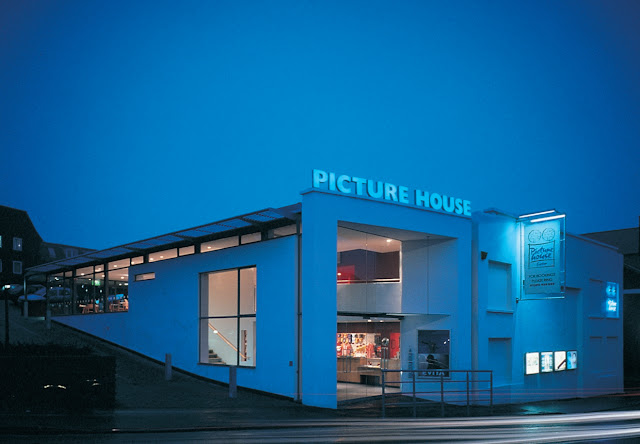"On the face of it, a quayside in Southampton Docks is not the obvious place to put a cinema. Seaside buildings are traditionally outward-looking, with big windows from which to scan the distant horizon. But a cinema is essentially a windowless box. Cinema auditoriums are often embedded in the densly packed buildings of a city centre. Only the main entrance and foyer are visible to the passers-by in the street. Burrell Foley Fischer therefore faced two main problems right from the start: how to relate the spaces within the building to the surroundings, and how to give an isolated, windowless box a suitably elegant and eye-catching image.
The key to the solution of the first problem was the foyer. It might be impossible to relate the internal spaces of the auditoriums to their surroundings, but at least the foyer could benefit from the view of the sea, sky and boats. The practice therefore decided to place it on the side of the buildings facing the water. But is went further than that. In the absence of a well-defined public space such as a high street, the architect provided its own public space in the form of a raised platform sloping down from the foyer to the dockside. This could be used for street theatre performances and outside film screenings on summer evenings. In this way, the building would make the most of the positive qualities of the site and give something back for the public's benefit. Site and building would combine to make a new, special place.
The second problem - how to make a windowless box into a public building of public character - demanded a different kind of solution. What were the options? The budget for the building was too small to allow for any great complexity in the form of the building, and in any case the unusual ground conditions, which would require expensive piled foundations, suggested a simple, compact form with a small footprint. Perhaps this was just as well. Ocean Village, despite its romantic name, was a rather disappointingly low-key environment - a scattering of rather nondescript buildings surrounded by car parks. What is needed was a landmark. The regional film theatre might provide it, but it would have to be more than simply a plain box. The answer lay close at hand, in the boats moored in the adjacent marina, and in the memory of the big ships that once loomed massively over this quayside.
'If we have to accommodate the whole foyer under the rake of the auditoriums,' said a design team member, 'the ceiling could reflect the sensuous lines of a boat hull.' Immediately it became apparent that this was not only possible, but was doubly appropriate. The auditoriums were already boat-like in form. It was necessary only to emphasize this quality by exposing their undersides and allowing their forms to 'read' on the exterior. The result would look something like a boat that had been lifted out of the water on to the dockside. It would not be a literal copy of a boat, like an exhibit in a theme park; the boat image was merely a starting-point and an inspiration. But it solved the problem in a satisfying way. It felt right, and the details of the design team began to fall into place."
blog.jpg)
















